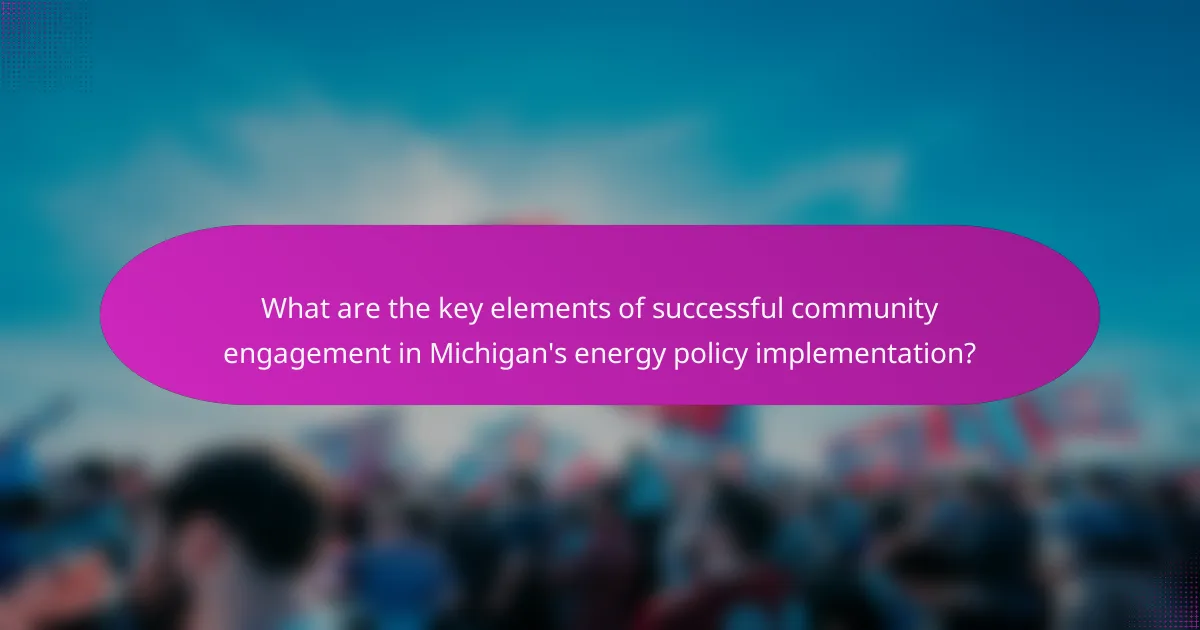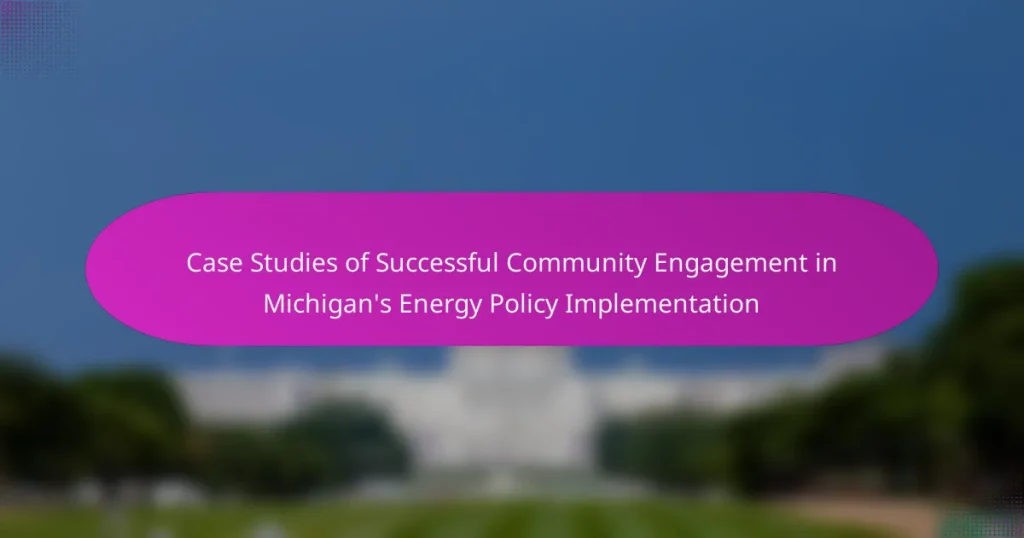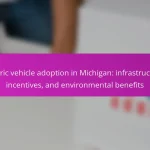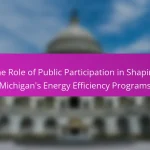
What are the key elements of successful community engagement in Michigan’s energy policy implementation?
Successful community engagement in Michigan’s energy policy implementation involves transparency, inclusivity, and collaboration. Transparency ensures that community members are informed about energy policies and their implications. Inclusivity involves engaging diverse groups to represent various perspectives and needs. Collaboration fosters partnerships between government agencies, local organizations, and residents. Effective communication channels are essential for sharing information and gathering feedback. Trust-building activities enhance community relationships and encourage active participation. Continuous evaluation of engagement strategies helps refine approaches based on community feedback. These elements collectively contribute to a more effective and accepted energy policy implementation in Michigan.
How does community engagement influence energy policy outcomes?
Community engagement significantly influences energy policy outcomes by ensuring that local voices and needs are considered in decision-making. Engaged communities can advocate for specific energy solutions that reflect their unique circumstances. This involvement often leads to more effective and accepted energy policies. Research shows that when communities are involved, policies are more likely to gain public support and trust. For instance, a study by the Michigan Public Service Commission highlighted that community input led to the successful implementation of renewable energy initiatives. These initiatives resulted in increased investment and participation from local stakeholders. Overall, community engagement fosters transparency and accountability in energy policy development.
What are the essential strategies for effective community involvement?
Essential strategies for effective community involvement include fostering open communication, building trust, and encouraging participation. Open communication allows community members to express their views and concerns. Trust is built through transparency and consistent engagement. Encouraging participation involves creating opportunities for individuals to contribute to discussions and decisions.
Research shows that communities with strong engagement strategies see higher satisfaction levels. For instance, a study by the Michigan State University Extension found that inclusive practices lead to more effective policy outcomes. This evidence supports the importance of these strategies in successful community involvement.
How do community values shape energy policy decisions?
Community values significantly influence energy policy decisions. These values reflect the priorities and concerns of residents. Policymakers often consider public opinion when formulating energy strategies. For instance, communities that prioritize sustainability may advocate for renewable energy sources. This can lead to policies that promote solar or wind energy development. Research shows that community engagement leads to more effective energy policies. A study by the Michigan Public Service Commission highlights successful community input in energy planning. The alignment of policies with community values fosters greater public support. This results in smoother implementation of energy initiatives.
What challenges do communities face in engaging with energy policy?
Communities face several challenges in engaging with energy policy. Limited access to information often hampers effective participation. Many community members lack understanding of complex energy regulations. This complexity can lead to confusion and disengagement. Additionally, inadequate representation in policy discussions can marginalize community voices. Economic disparities may prevent some communities from participating fully. Time constraints also limit engagement opportunities for busy residents. Furthermore, distrust in governmental processes can hinder collaboration. These factors collectively impede meaningful community involvement in energy policy decisions.
What barriers exist to effective community participation?
Barriers to effective community participation include lack of awareness, limited access to information, and insufficient trust in authorities. Many community members are unaware of opportunities to engage. Limited access to relevant information can hinder informed participation. Additionally, distrust in local government or organizations can discourage involvement. Research shows that these barriers significantly reduce community engagement efforts. A study by the Kettering Foundation highlights that when communities feel excluded, participation rates drop. This suggests that addressing these barriers is essential for fostering effective community participation.
How can communities overcome these challenges?
Communities can overcome challenges in energy policy implementation by fostering collaboration among stakeholders. Engaging local residents, businesses, and government entities creates a shared vision. Establishing clear communication channels ensures transparency and builds trust. Providing educational resources empowers community members with knowledge about energy options. Utilizing local leaders as advocates can mobilize support and participation. Implementing pilot projects demonstrates feasibility and encourages broader acceptance. According to the Michigan Energy Office, successful community engagement can lead to increased renewable energy adoption and reduced costs.

What are notable case studies of community engagement in Michigan’s energy policy?
Notable case studies of community engagement in Michigan’s energy policy include the Michigan Energy Options initiative and the Detroit Renewable Energy Partnership. The Michigan Energy Options initiative focuses on local energy efficiency programs. It engages communities through workshops and outreach efforts. This initiative has successfully reduced energy consumption in various municipalities.
The Detroit Renewable Energy Partnership involves local stakeholders in renewable energy projects. It aims to increase access to clean energy in underserved communities. This partnership has facilitated the installation of solar panels in residential areas. It has also provided educational resources about renewable energy benefits.
Both case studies demonstrate effective community involvement in shaping energy policies. They highlight the importance of local input in energy decision-making processes.
How have specific communities successfully engaged in energy policy initiatives?
Specific communities have successfully engaged in energy policy initiatives through grassroots organizing and collaboration. For example, the city of Ann Arbor developed a community-wide energy plan that involved residents in decision-making processes. This plan aimed to reduce greenhouse gas emissions by 25% by 2025. The initiative included public forums and surveys to gather input from diverse stakeholders. Another example is the Michigan Energy Innovation Business Council, which unites businesses and organizations to advocate for clean energy policies. This coalition has successfully influenced state legislation to support renewable energy development. These community efforts demonstrate effective engagement through participation and advocacy, resulting in impactful energy policies.
What strategies were used in the case of [specific community]?
It is not possible to provide a specific answer to the question regarding the strategies used in the case of a specific community without knowing which community is being referenced. Each community may have unique strategies based on their specific context and needs.
What were the outcomes of [specific community]’s engagement efforts?
It is not possible to provide a specific answer without knowing the name of the community in question. Each community’s engagement efforts yield unique outcomes based on their specific initiatives and contexts. Please provide the name of the specific community to receive an accurate response.
What lessons can be learned from these case studies?
Lessons from these case studies include the importance of active participation. Engaging community members fosters trust and collaboration. Successful initiatives demonstrate that tailored communication strategies are essential. Clear messaging ensures community understanding and involvement. Additionally, leveraging local leaders enhances credibility and outreach. These case studies show that sustained engagement leads to better policy outcomes. Evidence from Michigan’s energy policy implementation supports these findings. Community-driven efforts resulted in increased support for energy initiatives.
How can these lessons inform future community engagement efforts?
The lessons from successful community engagement in Michigan’s energy policy implementation can guide future efforts. They highlight the importance of building trust between stakeholders and the community. Engaging residents early in the process fosters a sense of ownership and collaboration. Tailoring communication strategies to meet diverse community needs enhances participation. Utilizing local leaders as advocates can amplify outreach effectiveness. Data from the Michigan Public Service Commission shows increased community involvement leads to better policy outcomes. These insights can shape more inclusive and effective engagement strategies moving forward.
What best practices emerged from these successful case studies?
Best practices from successful case studies in Michigan’s energy policy implementation include active community involvement, transparent communication, and collaborative partnerships. Engaging local stakeholders early in the process fosters trust and buy-in. Providing clear, accessible information helps demystify complex energy policies. Collaborative efforts between government, NGOs, and community organizations enhance resource sharing and expertise. Utilizing feedback loops allows for continuous improvement in engagement strategies. Establishing measurable goals ensures accountability and progress tracking. These practices have led to more effective energy policy outcomes, as evidenced by increased community participation and satisfaction in implemented initiatives.

How can communities enhance their engagement in Michigan’s energy policy implementation?
Communities can enhance their engagement in Michigan’s energy policy implementation by fostering collaboration and communication among stakeholders. Establishing partnerships with local governments, businesses, and non-profits can create a unified approach. Organizing community forums allows residents to voice concerns and share ideas. Providing educational resources helps residents understand energy policies and their impacts. Utilizing social media platforms can facilitate broader outreach and engagement. These strategies have been shown to increase participation in energy initiatives, as evidenced by successful case studies in Michigan. For instance, the Michigan Energy Office’s community engagement programs have led to increased awareness and participation in renewable energy projects.
What tools and resources are available for communities to improve engagement?
Communities can utilize various tools and resources to improve engagement. Digital platforms such as social media enable real-time communication and feedback. Community forums and workshops facilitate face-to-face interaction and idea sharing. Surveys and polls gather insights directly from community members. Local government websites often provide information on initiatives and events. Nonprofit organizations offer training and resources for effective community organizing. Collaborative tools like Google Workspace enhance teamwork and project management. Grant programs support funding for engagement initiatives. Research shows that communities with diverse engagement strategies see increased participation and satisfaction.
How can technology facilitate community participation in energy policy?
Technology can facilitate community participation in energy policy by providing platforms for communication and collaboration. Online forums and social media enable residents to voice their opinions and share information. Mobile applications can streamline surveys and feedback collection, ensuring diverse community input. Geographic Information Systems (GIS) can visualize energy data, helping communities understand local energy needs. Virtual town halls allow broader participation, overcoming geographical barriers. Data analytics can identify community preferences, tailoring policies to meet local demands. These technological tools enhance transparency and build trust between policymakers and residents.
What role do local organizations play in supporting community engagement?
Local organizations play a crucial role in supporting community engagement. They act as intermediaries between residents and policymakers. These organizations facilitate communication and information sharing. They often organize events to educate the community about energy policy. For instance, local nonprofits have hosted workshops to discuss renewable energy options. This helps residents understand their choices and impacts. Additionally, local organizations mobilize community members to participate in public meetings. Their efforts increase overall civic participation in decision-making processes. Studies have shown that communities with active local organizations are more engaged in energy initiatives. This engagement leads to more informed and collaborative policy outcomes.
What practical tips can communities implement for effective engagement?
Communities can implement several practical tips for effective engagement. First, establish clear communication channels to ensure information flows smoothly. Use social media, newsletters, and community meetings to reach diverse audiences. Second, involve community members in decision-making processes. This can increase buy-in and foster a sense of ownership. Third, organize regular events to facilitate interaction. These can be workshops, forums, or informal gatherings. Fourth, provide training and resources to empower community leaders. This equips them to engage others effectively. Fifth, gather and analyze feedback to improve future initiatives. Collecting data helps refine strategies and demonstrates responsiveness. Lastly, collaborate with local organizations to expand outreach efforts. Partnerships can enhance credibility and broaden impact. Implementing these strategies can lead to more engaged and informed communities.
How can communities build trust with stakeholders in energy policy?
Communities can build trust with stakeholders in energy policy by fostering open communication. Transparent dialogue allows stakeholders to voice concerns and ask questions. Regular meetings and forums can facilitate this communication. Sharing data and project updates enhances credibility. Involving stakeholders in decision-making processes creates a sense of ownership. Collaborating on local energy initiatives strengthens relationships. Research shows that communities with active engagement see improved trust levels. For example, Michigan’s energy policy implementation has benefited from such community involvement.
What are the key steps for organizing a successful community forum on energy policy?
Identify objectives for the community forum on energy policy. Objectives should align with community needs and energy goals. Engage stakeholders early in the planning process. This includes local government, community organizations, and residents. Select an appropriate venue that is accessible to all participants. The venue should accommodate the expected number of attendees comfortably. Develop a clear agenda that outlines discussion topics and time allocations. The agenda should encourage participation and inform attendees about key issues. Promote the forum widely through various channels. Use social media, local newspapers, and community bulletins to reach a broad audience. Facilitate the forum effectively to ensure all voices are heard. Use moderators to guide discussions and keep the conversation focused. Collect feedback from participants after the forum. This can help assess the effectiveness and gather insights for future events.
The main entity of the article is community engagement in the context of Michigan’s energy policy implementation. The article examines key elements of successful community engagement, including transparency, inclusivity, and collaboration, and how these factors influence energy policy outcomes. It discusses essential strategies for effective involvement, challenges communities face, notable case studies, and practical tips for enhancing engagement. Additionally, the article highlights the role of local organizations and technology in facilitating participation and building trust among stakeholders.


